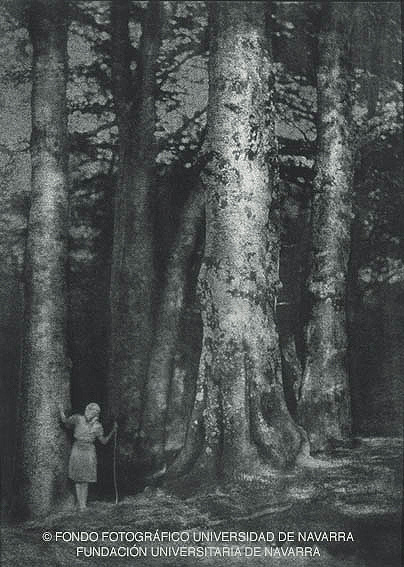The piece of the month of November 2005
JOSÉ ORTIZ ECHAGÜE
RONCESVALLES FORESTS, c. 1945
Dr. Asunción Domeño Martínez de Morentin
Chair of Navarrese Heritage and Art
University of Navarra Photographic Fund
In his travels throughout the Spanish geography, Navarre is also a point of inspiration for the images of the most relevant Spanish photographer of the first half of the 20th century in our country. The photograph was taken for the second great thematic series undertaken by José Ortiz Echagüe, dedicated to the "towns and landscapes" of Spain. After the bloody events of the Civil War, in which the photographer witnessed the disappearance of his two eldest sons on board the Wayside Cross "Baleares", José Ortiz Echagüe did not feel like returning to San Sebastián, where the whole family spent the summer months. The sea brought back sad memories and opened painful wounds. For this reason, in the years following the end of the war, he decided to change the sea for the mountains and chose a place he already knew from his previous adventures, Roncesvalles and its neighboring valleys. He went there in 1943 with his whole family, staying at the Inn in the nearby town of Burguete where, in addition, some relatives lived. The landscape and the people of Navarre deeply touched the feelings of the photographer from Alcarria -as well as his fondness for pelota-, to the point of expressing his intention of acquiring some old property to perpetuate his visits to this land.
In his summer stays of this year and the following ones, he traveled on foot and by car through different enclaves of the area -Roncesvalles, Garralda, Aria, Aribe, Uritz-, reaching as far as Ochagavía and Roncal, to meet their people and take snapshots of their traditional clothing, their customs or the landscapes surrounding the towns. His walking routes frequently ended at the Collegiate Church of Roncesvalles where he had become close friends with the then canon Agapito Martínez Alegría. And, of course, those walks were directed to the lush beech and oak forests that surrounded the monastery and in which he obtained an interesting repertoire of photographs in which to make nature dialogue with man. There were up to twelve images in which the photographer collected suggestive corners of the forest with a fully romantic sense in the employment of the lights, the composition or the chosen point of view.
They are, at all times, images presided over by a delicate intimacy and endowed with an air of mystery due to the impenetrability of the mass of trees and the presence of a human character that, far from clouding the landscape, adds to the mystical solitude of nature. The landscape imposes its grandeur against man and the old beech trees are imperturbable, as mute witnesses of the passage of time. In spite of the romantic accent that these images have, José Ortiz Echagüe has not chosen a sublime or violent nature, but an intimate and solitary environment, full of spirituality, before which the photographer adopts a contemplative attitude. The light, with its silvery reflections in the manner of Corot, carves the profile and the textures of the rough trunks that are arranged at different levels of depth accentuating, at the same time, the ascending tendency of the composition.
In this scenario in which the trees are shown as imposing masts, a delicate female figure slides, shown from behind, hiding her face and her identity. She carries a staff that alludes to her condition of walker, a patron saint that appears in most of the photographs taken by José Ortiz Echagüe in the forests of Roncesvalles, and a resource that is used insistently in the romantic painting and literature and, especially, in the nineties, close to which the work of this photographer is situated. Contributing to accentuate the aesthetic effect of the image is the technique used by Ortiz Ehagüe, direct charcoal on Fresson paper, which incorporates a gelatin emulsion and pigments -watercolor powders-, which gives it a different appearance from a conventional photograph, full of nuances, iridescence and a velvety texture, underlined by the ivory tone of the paper.
I invite you to identify with the walker in the photograph and contemplate through Ortiz Echagüe's eyes the serene and captivating beauty of this landscape made image.

